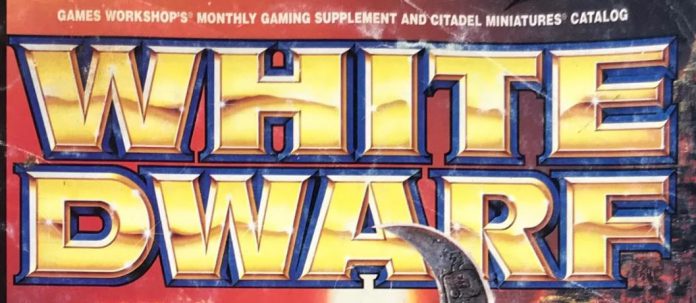Since the earliest days of Games Workshop, White Dwarf has been a constant staple of the hobby. Long before – and all the way through – the internet era, the monthly magazine slash catalogue slash extended advert for GW has shown us conversions, rules, reviews, battle reports and much, much more and has (almost) unfailingly been the leading light in GW’s public facing output. For many of us, the feeling of getting the new edition of White Dwarf and eagerly scanning the contents for our favourite systems or authors is still a fondly remembered part of the hobby – as exciting as opening that new Goonhammer Gazette email on a Monday!
If you’re a hobbyist of a certain vintage, it was almost certainly one of your first encounters with Space Marines and Orcs and Elves, so it’s time for us to gather our longbeards to look back on Goonhammer’s favourite White Dwarfs and talk about why it was such an important part of our hobby journeys.
Lenoon
First White Dwarf: I’d been picking up the occasional White Dwarf or checking out friends issues for a year or so before I fully dived in to this black hole of a hobby. The first White Dwarf I bought was 201, which is a pretty standard issue of that era – the first I bought in the long, long run of continuous buying and subscriptions until White Dwarf itself died was 216.
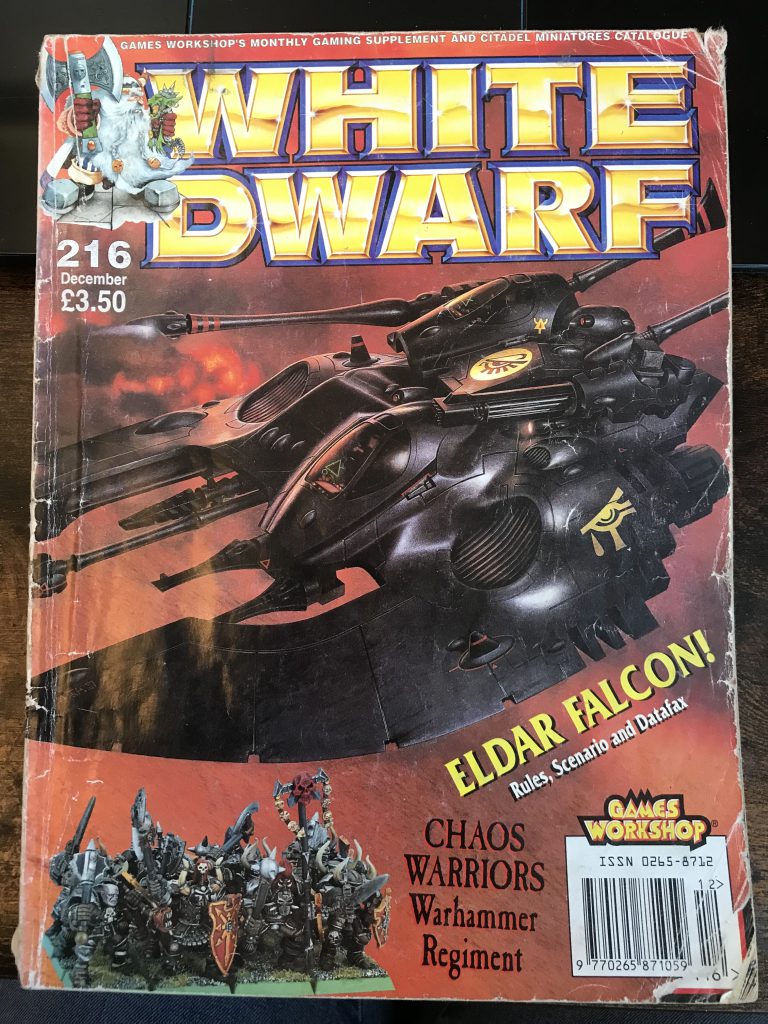
Oh 216. I will forever love you. The release of the Eldar falcon, articles on Imperial Guard that got me into Epic 40,000 long before I picked up a 40k model, Gorkamorka kickstarted an interest in the game that has lasted to the current day, an Ian Pickstock short story about assassins, the first multi-part plastics of the modern era in the Chaos Warriors, the mail order pages for component purchases, all the elements of what made White Dwarf absolutely fantastic throughout the late 90s to mid 00s. What caught my imagination, never to let it go, was the battle report – Eldar striking hard and fast at a combined Marine and Guard army. Impeccably illustrated, beautifully painted, strategy and tactics and luck and everything else you could want. It told me something simple but important – this was a game you could play. So I did. And I still am.

It was the very beginning of major changes at White Dwarf and GW generally. The opening of the Lenton Store – not quite Warhammer World yet – was announced in this issue, and the editorship of Paul Sawyer was in it’s very early days. Paul would be WD editor for seven years, the longest single tenure of any editor – forging what might well be the golden age of White Dwarf.
Favourite battle report: I really thought about this one – a half-remembered Elves vs Demons in 5th edition fantasy? Something clever I could point to about how a battle report ended up in the fluff, proving once and for all that basically whatever Andy Chambers and Jervis Johnson randomly rolled is now treated as gospel by lore idiots? Nah.
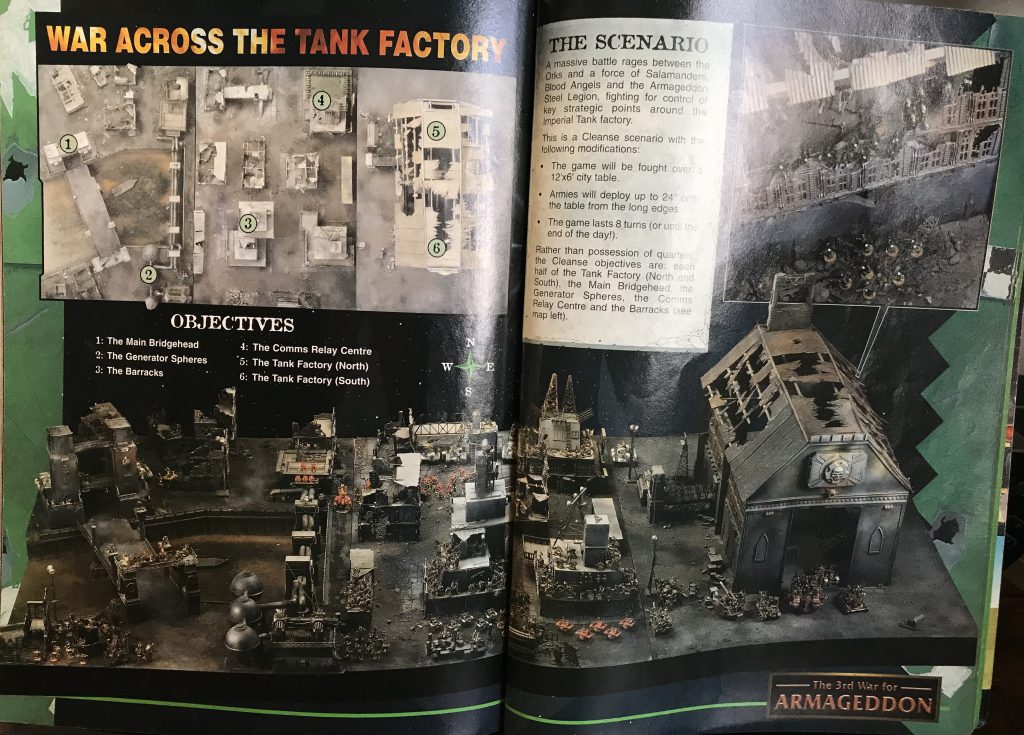
It’s the Battle for Armageddon. Four linked battles, 12 armies, earthshaker batteries being thrown across games, split over two WD’s, written up as a narrative, all just a huge, massive shitshow of fun and chaos. It was really aspirational gaming and all done in 3rd edition 40k, making the armies assembled for this once in a decade mega-battle seem hilariously small to modern eyes. The battle report kicked off the mega-campaign in style, and I still, 20 years later, want to fight it out. I wonder where that tank factory went?
Corrode
First White Dwarf: Something I’ve never forgotten, issue 252 with the Empire Knights on the cover. As first issues go, I don’t think I could have asked for much better, with the key feature being the first battle report using the Carnage mission. It’s incredibly eventful, and in my mind is the ideal battle report format for a magazine like White Dwarf – it’s not necessarily a fair or competitive way to play a game, it’s all about creating big moments and cool stuff happening, but there’s some logic bounding the whole thing so the game that plays out makes sense.
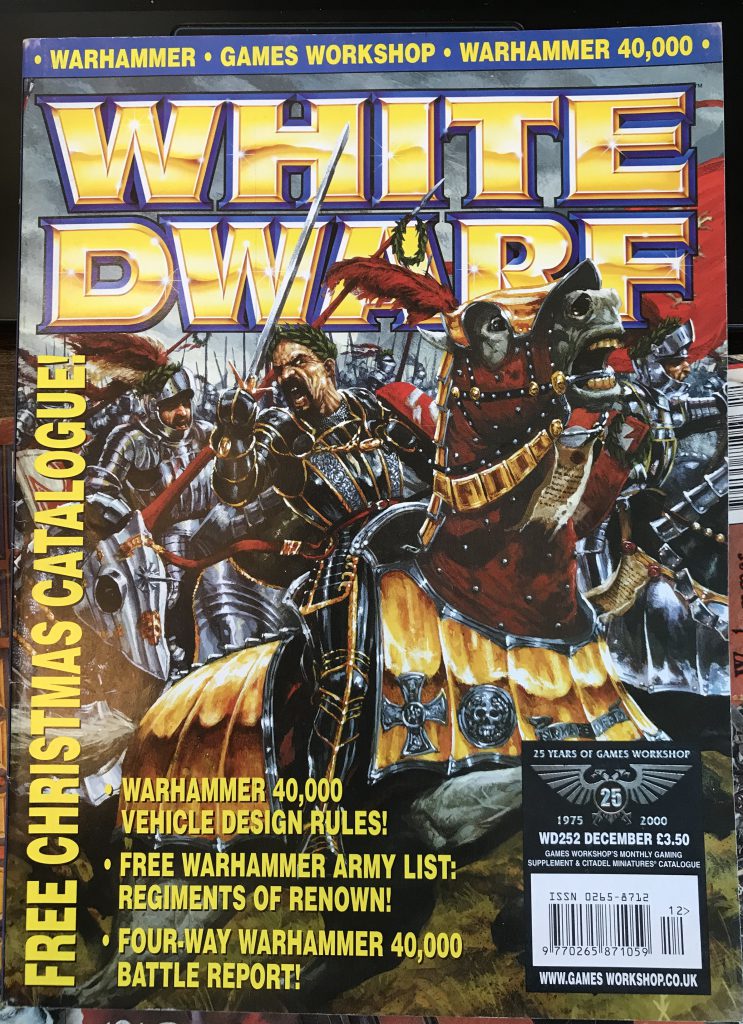
Elsewhere in the issue there is an Index Astartes on that key tome, the Codex Astartes – hugely useful to me as a 10 year old trying to make sense of what a Space Marine was, exactly – and a lengthy section on Nick Davis’ Space Hulk board, from back in the days when terrain articles were about making terrain out of whatever trash you could find around the house (or in B&Q) rather than about selling you a plastic kit that would be in production for six weeks before being dropped. Chapter Approved: Vehicle Design Rules, an article on theming armies, another scenery article about making woods and trees, an Ulthwé tactica from Phil Kelly – not even touching on the Fantasy side, or the general hobby goings-on. When I think of White Dwarf, to this day it’s this one I think of.
Highlights: I think in general that 2000-2003 run is really strong, though that may also be early adolescence talking; still, it’s hard to argue against Index Astartes, a series which is foundational to the setting and really put flesh on the bones of the Space Marines (of both persuasions) as the animating force of 40k. I was always a big fan of the Mike Walker articles of that era, both because of their inherent quality but also as an aspirational thing – as a teenager who did a lot more reading and thinking about Warhammer than actually playing it, the goings-on of a regular gaming group sounded magical even in its dysfunctional elements. Battle reports of the era mostly seemed to be regular games being played, even if the generals were inept at best and the army list selections baffling; by contrast I remember picking up a late-2010s White Dwarf with a ‘narrative’ battle report which I barely understood because the scenario was such a mess, and bore so little relationship to games as I approach them, and wishing that there was more like this era of just slamming two armies into each other and using quality writing to add the sparkle to it.
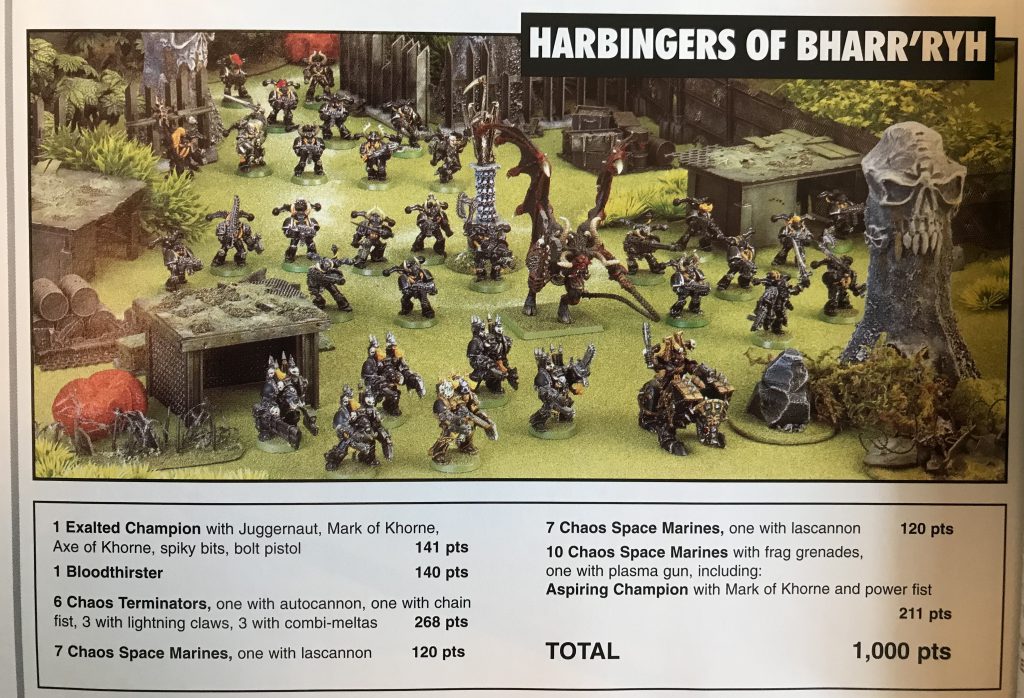
Despite being a chiefly 40k person both now and then, some of the articles I remember best are from the Warhammer Fantasy side; in particular there was a really good run where new army books for 6th edition came out accompanied by in-depth designer’s notes which took a very open look at what the studio was doing, why they made the choices they did, what their thoughts and approaches were in doing so, really fascinating stuff. The Tomb Kings and Beasts of Chaos ones are particular highlights in my mind, because both of them involved quite unusual things being done to set up somewhat unfavoured armies as being distinct from the factions surrounding them – and in retrospect I think in both cases it didn’t really work, but I didn’t know any better at the time. I bought both books and a scattering of models, which tells you that the article at least did its job of interesting me in them.
So much of what I loved about that era was the feel of the thing. There was a vitality to the magazine in those days, and a real sense that it was about people participating in the same hobby as you were – it always functioned as an in-house magazine to sell toys for a corporation, but it felt like less of an advert for the company so much as it was for the community you’d be joining in with, which coincidentally involved buying lots of GW’s products.
I think there was a convergence of factors after Paul Sawyer leaves and 5th/6th edition 40k and 8th edition WFB come into frame where the magazine slowly morphs into a glossier but emptier version of itself and becomes less and less interesting. Probably as much as anything else this has as much to do with me engaging with this hobby as an adult, and a very highly engaged adult at that, who is no longer remotely the target audience for White Dwarf – whereas for teenage me White Dwarf was the hobby. Much easier to blame it on the magazine for changing, though, and not the multiple decades between the current moment and the day I picked one up for the first time.
Musterkrux
First White Dwarf: I don’t recall exactly which was my first White Dwarf but I can tell you that issue 189 was the one that most successfully wormed its way into the soft meat of my brainards and has lived there rent-free for nearly three decades. I had recently purchased a Vindicare Assassin model as an adjunct to my tiny but well loved Ultramarines army. Issue 189 had the rules for Vindicare Assassins in it. I recall the robust negotiation I had with my father that day. I wanted, nay, needed that magazine if I was going to use my new sniper in battle. I was perhaps only 10, maybe 11 at the time, but I do recall that I was an absolute little shit about getting that magazine. In the end, I got it, but by golly I did not get ice-cream like everyone else in the family did that day. But that’s fine, I had the Vindicare rules. Victory in battle is a much sweeter taste than any confectionery.

Best Battle Report: Again, I’m sticking to Issue 189, as it had a glorious bat-rep between a combined army of Imperial Guard and the Eldar (Aeldari for the three of you reading this article who aren’t GW-tragic grognards) versus a single Tyranid swarm.
Back in second edition, this was 3,000 points of army:
Hive Tyrant x2, Lictor x2, Carnifex x2, Biovore and some Spore Mines, Hormagaunts x12, Gargoyles x12, Genestealers x12, Termagaunts x31, and something like 9 Tyranid Warriors
By rough calculations, I reckon that’s maybe 1500-1600 points in 10th edition, where 2,000 points was perhaps closer to the norm and a game of 2k points would last you an entire afternoon and most of an evening.
This battle report had amazing introductory fluff, with Eldrad popping over to the Imperials to explain, in a departure from his typically perfidious manner, that The Great Devourer must not be victorious here on Moloch III and that the Eldar would assist them. Eldrad peaces out with a line that has stuck with me for years: “All races will fall before the Devourer in time, together or alone.”
You can imagine, of course, how much this shit absolutely rocked my tiny, pre-teen brain at the time. From memory, the battle report goes on to explain how the Tyranids swept through the combined Imperial and Eldar forces, describing the individual events of the battle with a bit of narrative flair. I recall a line about the Eldar War Walker trying to go toe to toe with a Tyranid Warrior and ending up ‘skewered on the end of a bone sword like a piece of sweet-meat’.
They don’t write battle reports like that anymore.
How White Dwarf Has Shaped My Hobby Journey: Today we have youtube channels filled with videos that explain lore, how to paint models as well as discussing conversions and army building. I hear there are even some websites that do a similar thing.
Back in the mid to late 90’s when the internet was in the middle of its horrid birth, mewling in 8,000 baud modem handshakes, we didn’t have videos on demand or even many easily found websites dedicated to hobby, so White Dwarf was for many of us the older brother (senpai if you lean that way) that taught us about the hobby and how to hobby.
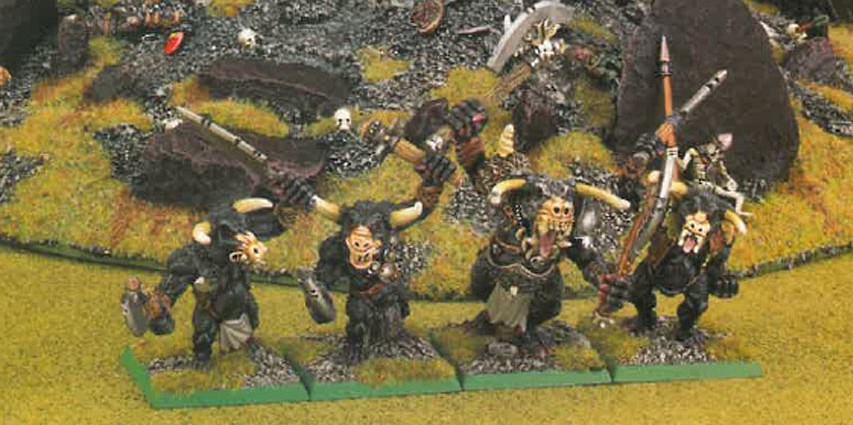
Articles about how to make kooky or insane conversions, ongoing campaign reports about home-brew chapters of space marines that became canon (I recall some of the stories of the Soul Drinkers), Games Workshop did a great job communicating the passion and creativity of this hobby in White Dwarf and in many ways it was both a product and salesperson for the company.
Togepi
Best White Dwarf: Without a doubt, Issue 300. I had been playing for about 18 months when it came out, so I was still new but at least experienced enough to have context for what I was reading, and Issue 300 sent my wig into orbit. Movie marines! The end of the Storm of Chaos! Tons of info on Ogre Kingdoms, the game’s newest faction! Rules for the White Dwarf himself! And more, and more, and more… the magazine was GIGANTIC.
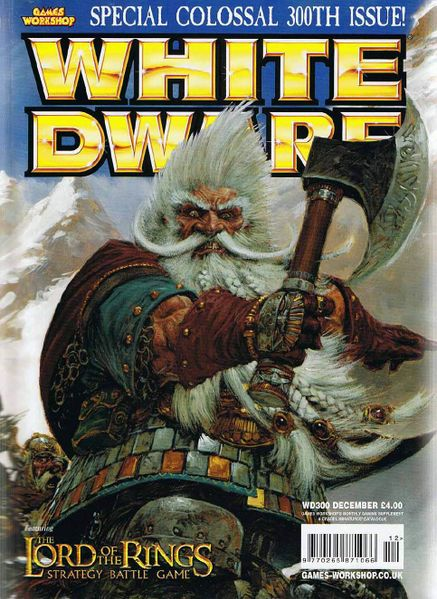
My biggest regret is not sending away from the White Dwarf model with the cutout coupon inside. I have no idea why I didn’t, I dearly wanted to. Just procrastination, I guess, and teenage lack of funds? It’s still available on eBay, but my pile of shame is far too large to justify an acquisition that I would only paint and stick in a display case.
White Dwarf 300 is probably the moment when I went from a game-loving teenager to a Wargamer. It showed me how enormous the world I had stepped into could be.
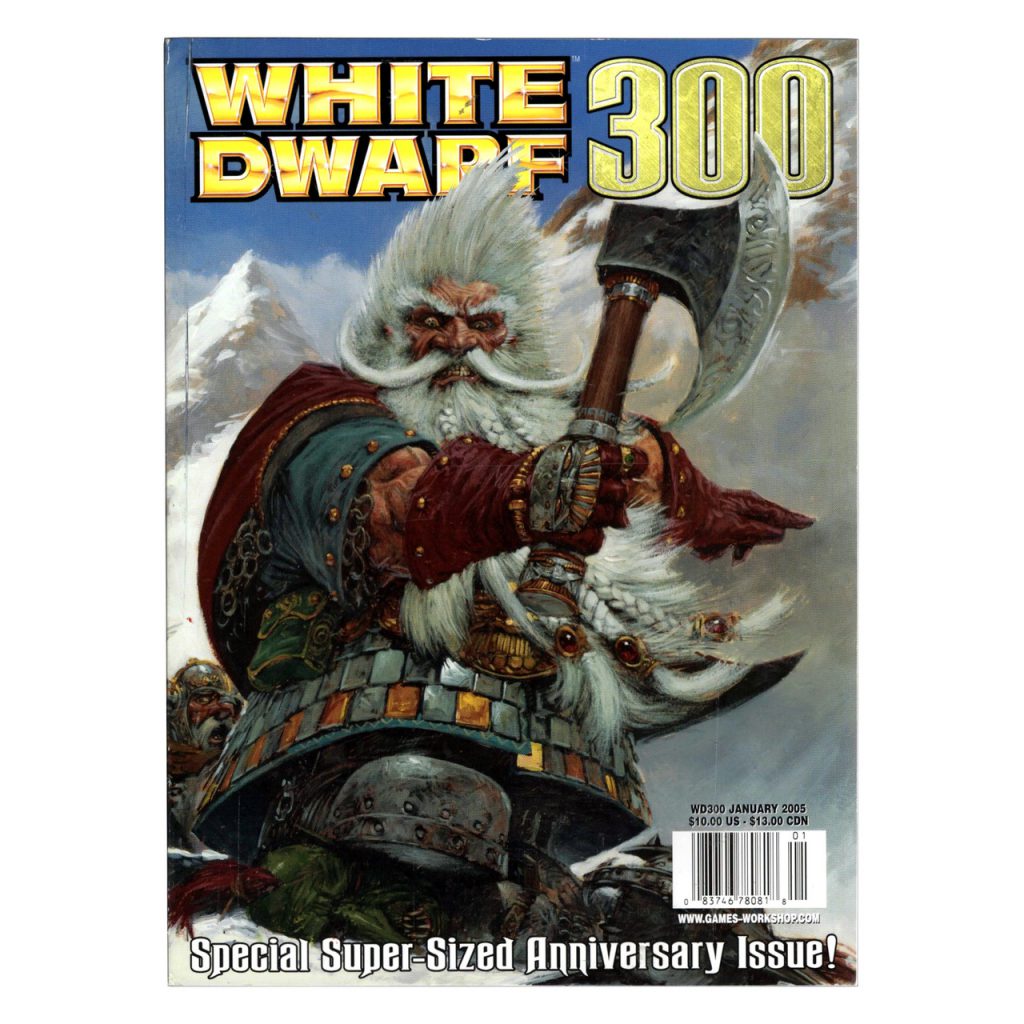
Conversions: Speaking of White Dwarf #300, the issue also included a fully converted Adeptus Custodes army, years before the first of the Ten Thousand stepped out of a Nottingham mold. The level of detail on these models was absurd, each one lovingly handcrafted by Dave Taylor in a pleasing alignment of Doylist and Watsonian principles. Each Custodian featured bits from Space Marines (both loyalist and heretic), High Elves, Grey Knights, and even some 54mm Inquisitor models.
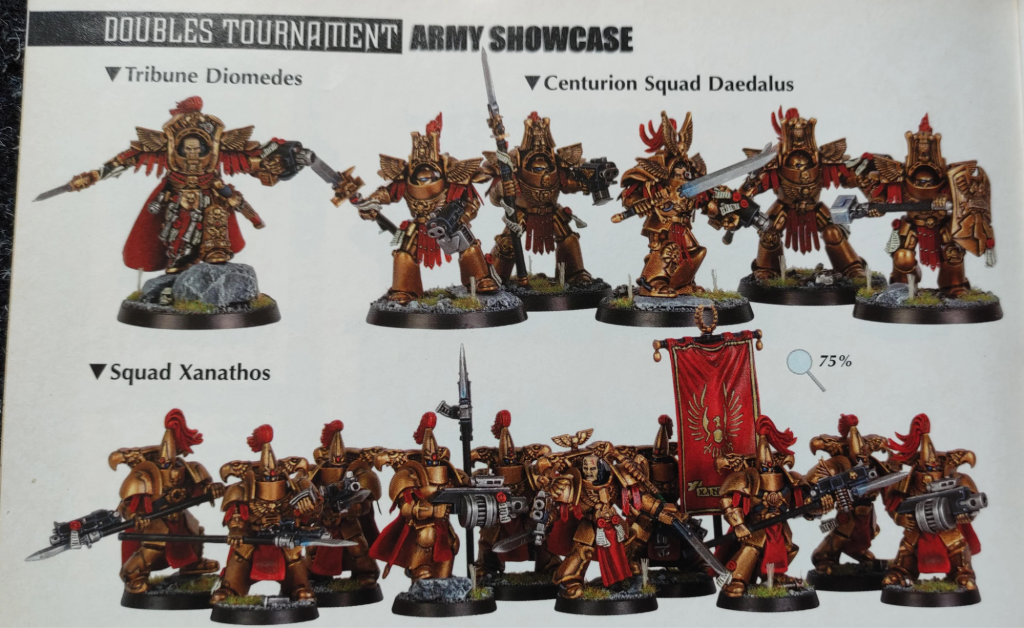
I had never seen anything like this, and while I was never tempted to play Custodes, I had longed for an Adeptus Mechanicus army ever since I learned that they existed. I eventually ended up converting a Skitarii tank and a Magos-Prime before running out of time, money, and attention span, but even though I’ve since acquired thousands of points of “real” Admech, those two still have pride of place in my display case. And I owe it all to White Dwarf, for showing me that sometimes you just need to sail off the edge of the map.
Articles That Stick in the Mind: Eric Sarlin’s Low Fantasy WHFB article (“A Grim World of Perilous Adventure” – sadly I cannot remember what issue it was from) blew my socks off when I first read it. I always knew that I liked the “grimy and gritty” aspects of WHFB much more than the polished and noble ones. My first army was Skaven, after all, and I took a kind of dark joy in imagining my filthy ratment dragging down haughty High Elven nobles. But I’d never heard the term “low fantasy” and didn’t realize that my personal preferences were the gateway to an entire subgenre of fantasy.
The article was pretty light on rules, featuring only a checklist of possible modifiers both players could agree to to make their game a “low fantasy” one (no wizards above a certain level, points limits for characters, limited chariots and artillery, etc.). Mostly, Sarlin discussed the philosophy behind Low Fantasy, its appeal, and why you might want to leave your dragons and monsters at home to slug it out in the mud.
I’m not a pure low fantasy guy, but I do still find myself drawn to the smelly, stupid idiot faction in most of my games (ask me about my Bayou collection). And my most recent project is a heavily converted Cities of Sigmar army with a distinctly low-fantasy aesthetic: brown, yellow and red, with lots of mud and blood. The City of Carcosa marches on…
Thundercloud
The first White Dwarf I got was 143, back in the heady days of November 1991, and it lit a fire that drew me from airfix style model kits and toy soldiers to the exciting new universe of Games Workshop games. This was a jam packed issue, featuring the first battle report of Epic 2nd edition, the rules to use the new Stompers! Boxed set, TWO Eavy Metal sections, one for 40k and one for Epic, the John Blanche concept art for Man O’War that would be released a mere two years later, a detailed modeling project guide to build a Coaching Inn and Stables and Imperial Guard colour schemes.
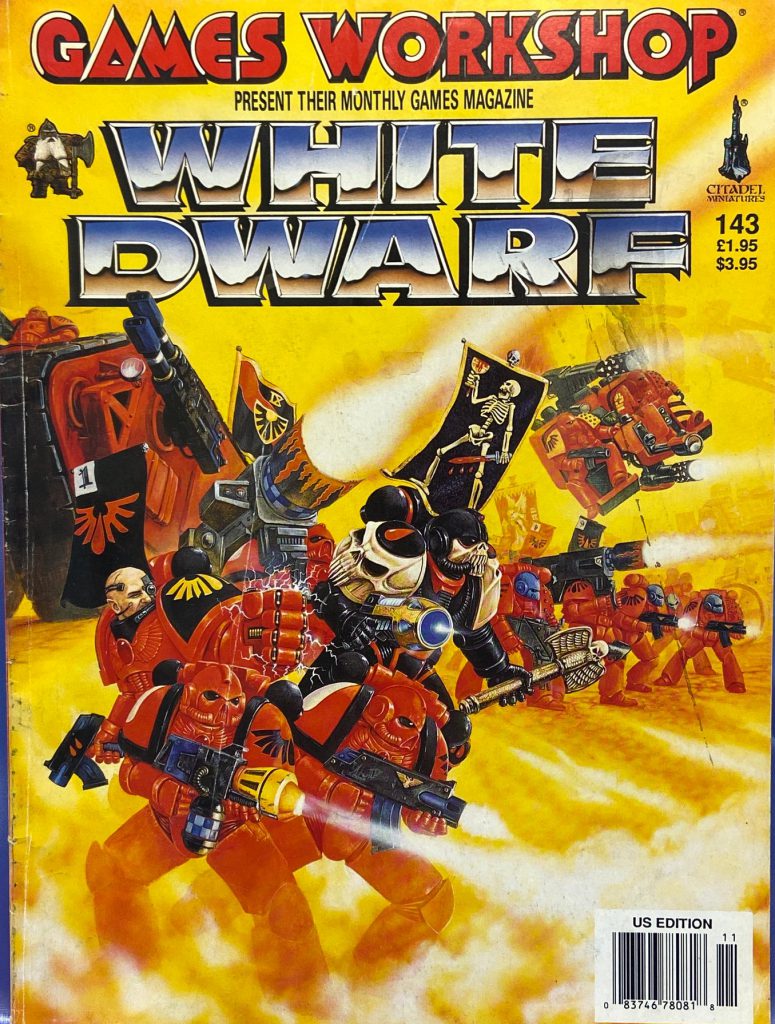
This was in the Rogue Trader era/Warhammer 3rd edition, and before GW started to build even bigger with the launch of 2nd edition 40k. But as you can see in the Stompers! Box art below, units like the Contemptor were almost in their final version before Rogue Trader gave way to 2nd edition, even if a proper Contemptor wouldn’t come to 40k for a couple of decades.

The Epic battle report was sweeping in scale, a 6000 point game with Titans and multiple companies, and cemented in my mind, and hence in the school gaming club that I was later part of, that big games was the way to go. It also introduced me to the Andy Chambers/Jervis Johnson rivalry (where I was resolutely team Andy) and Blood Angels as an army of choice.
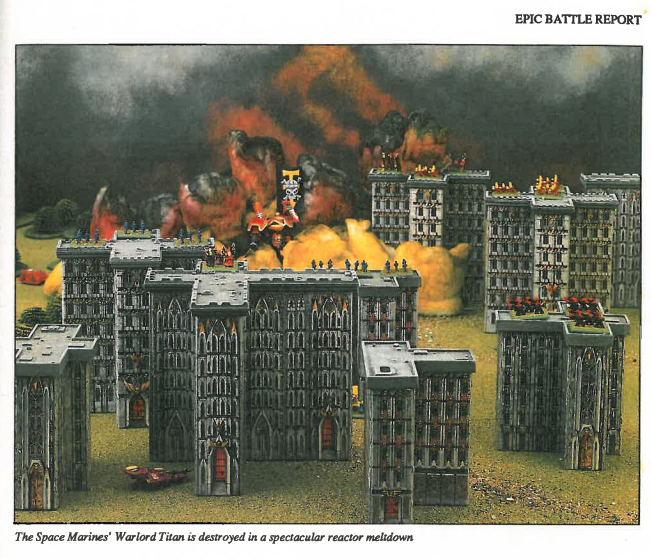
Favourite Battle Report: White Dwarf battle reports have so often been epic struggles between big armies bringing all the cool toys, easily purchasable at your local GW retailers, to show what an army can do.
Battle of Grimdal’s Tomb in White Dwarf 153 is different. In this report we see two forces just over 1000 points, each containing three units, a couple of characters, and a single figure taken from a unit in an allied list as an independent skirmisher. The goal is to recover a magical hammer from a tomb, which is inhabited by skeletons and a troll. The forces are built narratively around a central character and their retinue. It’s not super competitive, there are no monsters or war machines, and the battle report plays out as a narrative without being split into turns (which from reading it there appear to have been a fair few more than in a normal game). It’s a window into more casual, narrative play that you sometimes don’t get from GW battle reports, and where splitting the report into turns makes it much more clearly a game than a story.

It was also ironically the launch battle report for Warhammer 4th edition, using none of the new figures and featuring neither of the factions in the box. For that you had to wait until the Battle of Red Axe Pass in issue 155, which was another blisteringly good report.
How White Dwarf Has Shaped My Hobby Journey:
In the early 90s I read White Dwarf religiously, and collected a fair few of the older issues (120s, 130s) because you could get old issues of White Dwarf in stores then. It opened my eyes up to a lot of things, and I started to dabble in game design because of White Dwarf, and conversions, and a bunch of other things. The studio army being Blood Angels definitely influenced me (this was long before anyone gave even the tiniest of shits about Ultramarines) to collect Blood Angels in Epic and 40k, and White Dwarf was a constant source of stuff to stimulate my childhood ADHD brain.

Looking back the White Dwarf run from late Rogue Trader/3rd ed Warhammer to 40k 2nd edition/4th ed Warhammer was a pretty solidly good run. Battle reports developed into the classic White Dwarf format with maps that we’ve come to associate with GW, there were frequent rules snapshots of things in development or previews from new releases, and the modeling projects (it seems like the articles cover basically building a whole village worth of buildings) were pitched at a level that modelers with a reasonable level of skill could carry them off.
I think that our hobby habits are often shaped in the first few years we start in (so often our teenage years), and the White Dwarfs from the time are a big part in shaping this. In the years before the internet the influences were your local hobby community and your window into the world wide community was hobby magazines, of which White Dwarf was by far the biggest.
My current hobby journey, which to be honest is getting more disciplined, is heavily influenced by Rogue Trader and the sort of almost skirmish level gaming it often involved, rather than 40k as it currently is.
Skails
One of my earliest White Dwarf was issue 223, released for August of 1998. I’ve managed to hold onto this copy for the last 25 years. It’s jam packed with classic goodies.

Most memorable is that this issue had a mini game inside, Brewhouse Bash. It includes a card stock tavern board in two pieces, bringing it to approximately an 11x15in board. Punch out orks are included (“Of course we’ve only included these so that sad people who don’t have any Ork models in their collection can play the game.”) plus chair and bottle tokens. The game starts by randomly allocating wounds (D3+3) to each ork “to represent the amount of bashin’ they can take before they slump unconscious to the floor”. Then each player rolls a random skill from the “Bashin’ Skills Table”. Players roll off for who goes first and places their Ork on the floor level in that order. From here player gets two actions, or one action and use of their skill. I’ll let the image cover it from here. The game was fun and revisiting it make me feel the hobby twinge of recreating it three dimensionally. It felt like a great introduction to a lot of rules and concepts that still inform Warhammer games to this day.
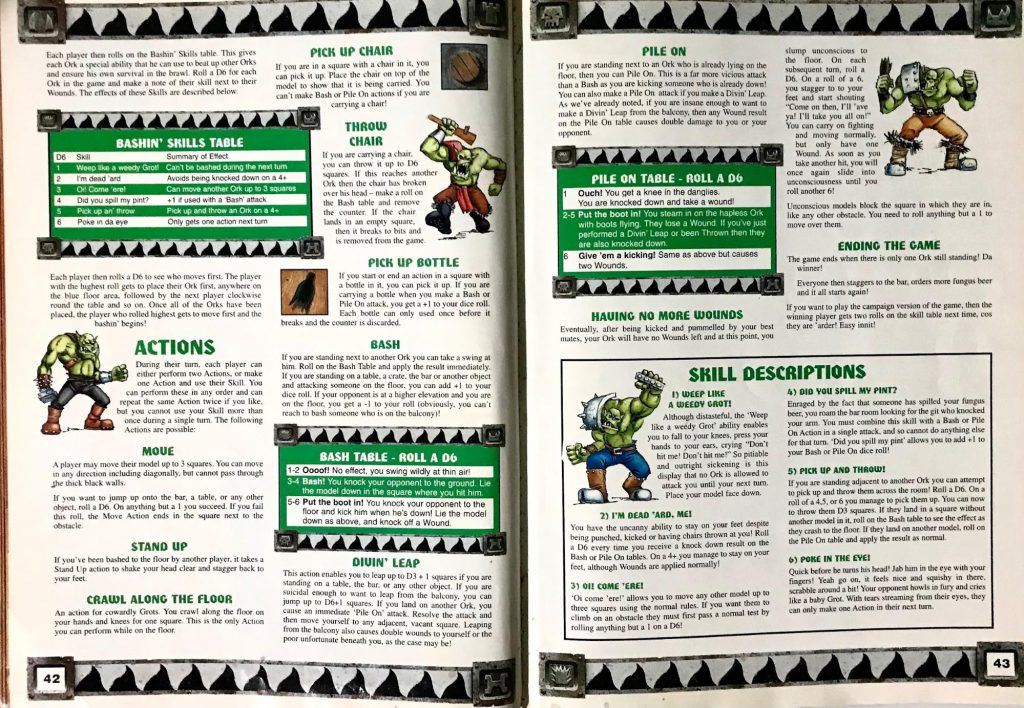
This issue included the first look at Tuomas Pirinen’s Mordheim concept, fairly early in the game’s development. It gives some background to the setting and talks about developing skirmish rules. There is so much more in here: models for Legion of the Damned were released that month (my brother ended up getting these models), there is a preview for Warhammer Siege, introduction to wargaming, making lizardmen terrain, painting the new plastic Empire soldiers regiment. I’ll leave it off with this picture of the mail order section from the back. Loved seeing all the bitz and it was so iconic of where the hobby was focused in the era.

“Contemptor” Kevin Stillman
As someone relatively new to the hobby, the White Dwarf that got me into the hobby was the March 2017 edition. This was the one that was accidentally shipped out early to someone, and blew the reveal that Roboute Guilliman was going to return to 40K. At that time I was more of a lore-head: I enjoyed reading the books, reading the lore on Wikipedia, and watching “If the Emperor Had a Text to Speech Device” on YouTube (yeah, back when that was A Thing). But the announcement that Guilliman was returning was the push I needed to begin learning *how* to paint 40K to a higher standard. So instead of having a small collection of Tactical Marines and a Land Raider and a Rhino, I would need an army to go alongside Guilliman.

And here we are.
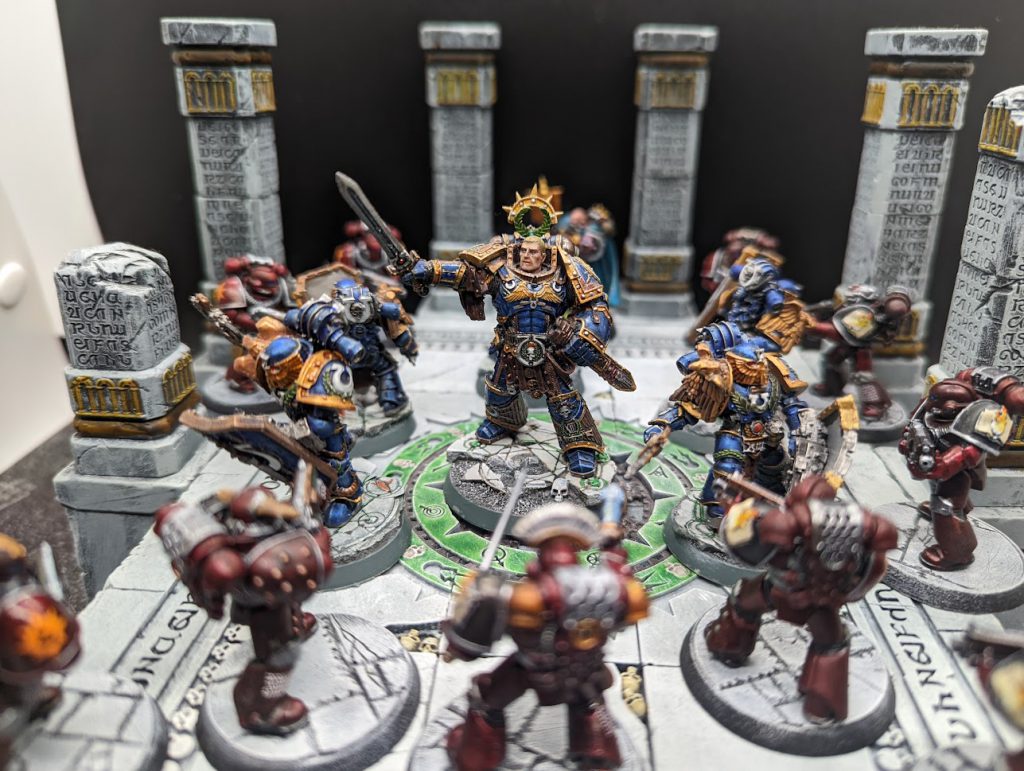
Dylon
First White Dwarf: My memory has failed me on this one, but I think….. My first issue was US #212. Which is an absolute banger of a magazine. It’s loaded with a sample from the Sisters of Battle Codex, Orks for Epic 40,000, building and Epic gaming table on a budget, part 2 of the Studio Warhammer campaign run by Rick Priestly, a Games Day and Golden Daemon recap, the preview of Gorkamorka and a section highlighting the artwork of John WIgley. Nick Davis’s Lizardmen on the back cover earned many minutes of study. The cardboard chapel that was included was built immediately and just as quickly warped since it’s very thin. Despite that it still saw many years of use. This era of White Dwarf, though helmed by Robin Dews, was still tongue and cheeks and very British, which to a young, sheltered kid from the USA was exotic and very funny.
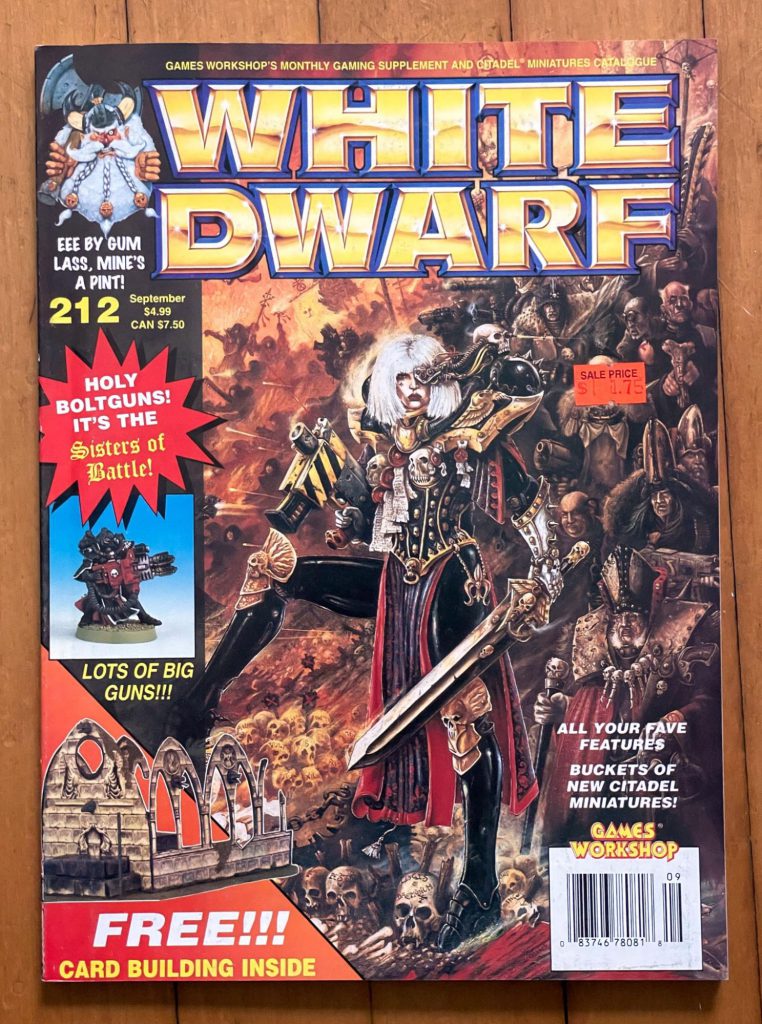
Battle Report: In the very next issue, was a series of battle reports pitting the new Sisters of Battle against three foes, Chaos, Eldar, and Orks. While these battle reports were not the usual in-depth affairs, the narrative behind the games and the terrain setups were striking to a young me. And unrelated, but the spread of Warwick Kinrade’s Dark Angels was hugely inspiring and probably the reason my first Space Marines were Dark Angels.
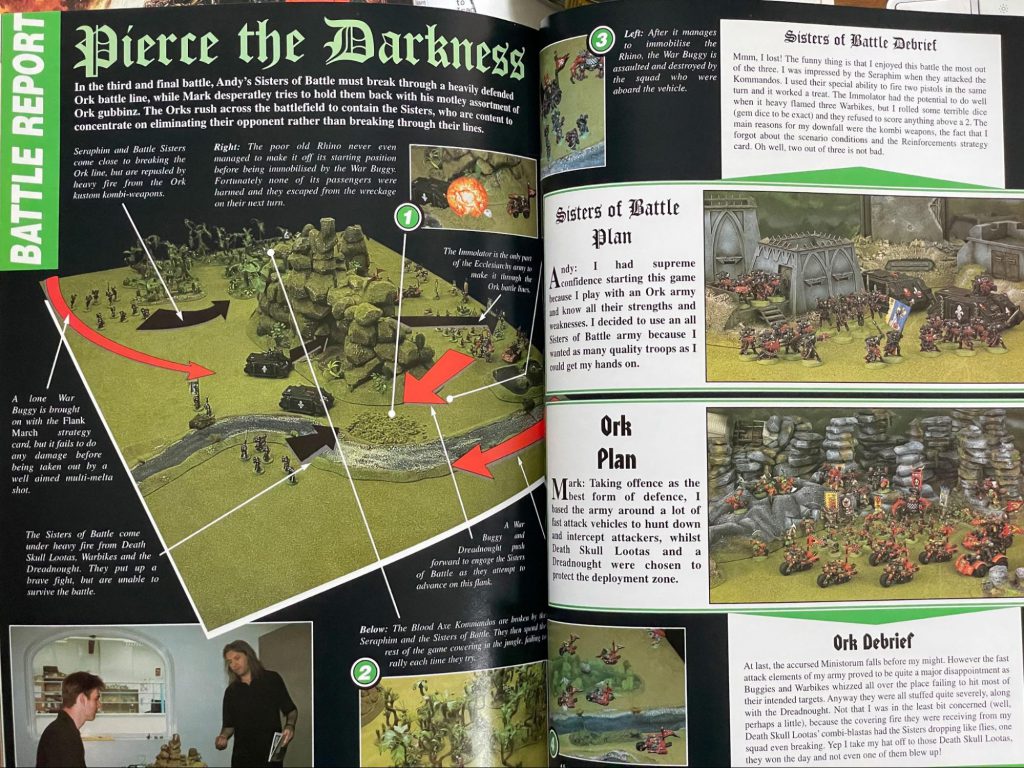
How WD influenced my hobby journey: The early White Dwarfs I got were massively influential, and the ethos of the team at that time had much to do with it. I’ve been fortunate to chat with Nick Davis about his time on the team and how they approached the articles and content they made. The mandate from Fat Bloke was to show how to have fun with the games and hobby; make the hobby approachable and accessible.

TheChirurgeon
First White Dwarf: My First White Dwarf was issue 201, from October 1996. I was living in Italy at the time and picked that bad boy up, in part because it had info on Kharn and Space Marine bikes. I was pretty hooked early on, having been part of the HeroQuest-to-Warhammer pipeline carefully engineered by Games Workshop and Milton Bradley in the early 90s. I picked up the magazine pretty regularly from there and have on many occasions been forced to throw out large stacks of the magazine when moving. Most notably, the magazine was the inspiration for my White Panthers space marines army – I saw their scheme in and issue and fell in love with it.
But really I want to talk about when White Dwarf truly became a must-buy for the hobby: Issue 254, when the first in what would become a monthly series of articles published, each one detailing either one of the first founding space marine chapters or a related issue, like the cursed founding or Librarians.
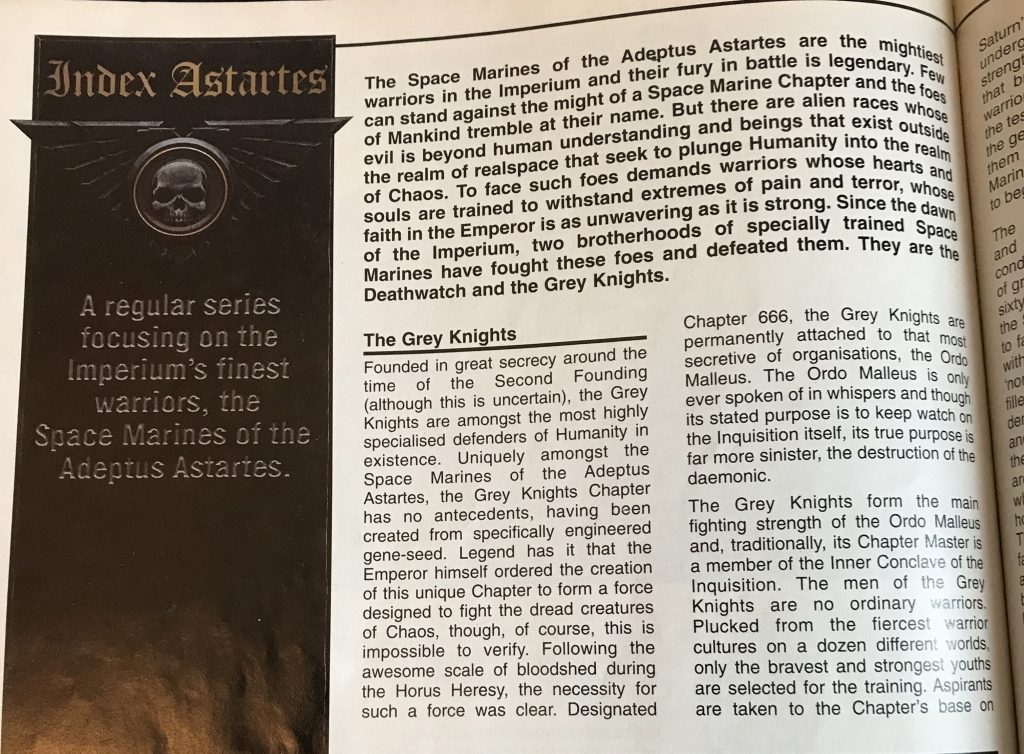
The series kicked off with Dark Angels in February 2001 with issue 254, introducing us to new lore and some interesting backstory for the Unforgiven. And that was fine. But then in March, issue 255 gave us the same article but for the Emperor’s Children and that’s when everything changed. For the first time we got detailed lore on the III legion, introducing us to aspects of the legion’s backstory that had never been revealed, such as the scouring of Laeran and introducing us to Commander Eidolon. What’s more, the issue gave us our first rules for playing Emperor’s Children armies using Codex: Chaos Space Marines, bringing forward a number of rules which would see reprints in Codex: Chaos Space Marines late the following year.
This kickstarted a lore renaissance for 40k, with a number of elements that would later be fleshed out – and often changed – in the Horus Heresy novels, but for most of the chapters and legions giving us the fully fleshed-out lore that we’d know today. These lore articles also included new rules and often coincided with upgrade kit releases, such as those for the Iron Warriors, Thousand Sons, and White Scars. The series continued on through issue 277, when they finally completed it with the Alpha Legion. Those articles would later be republished in the Index Astartes Books, four volumes in total.
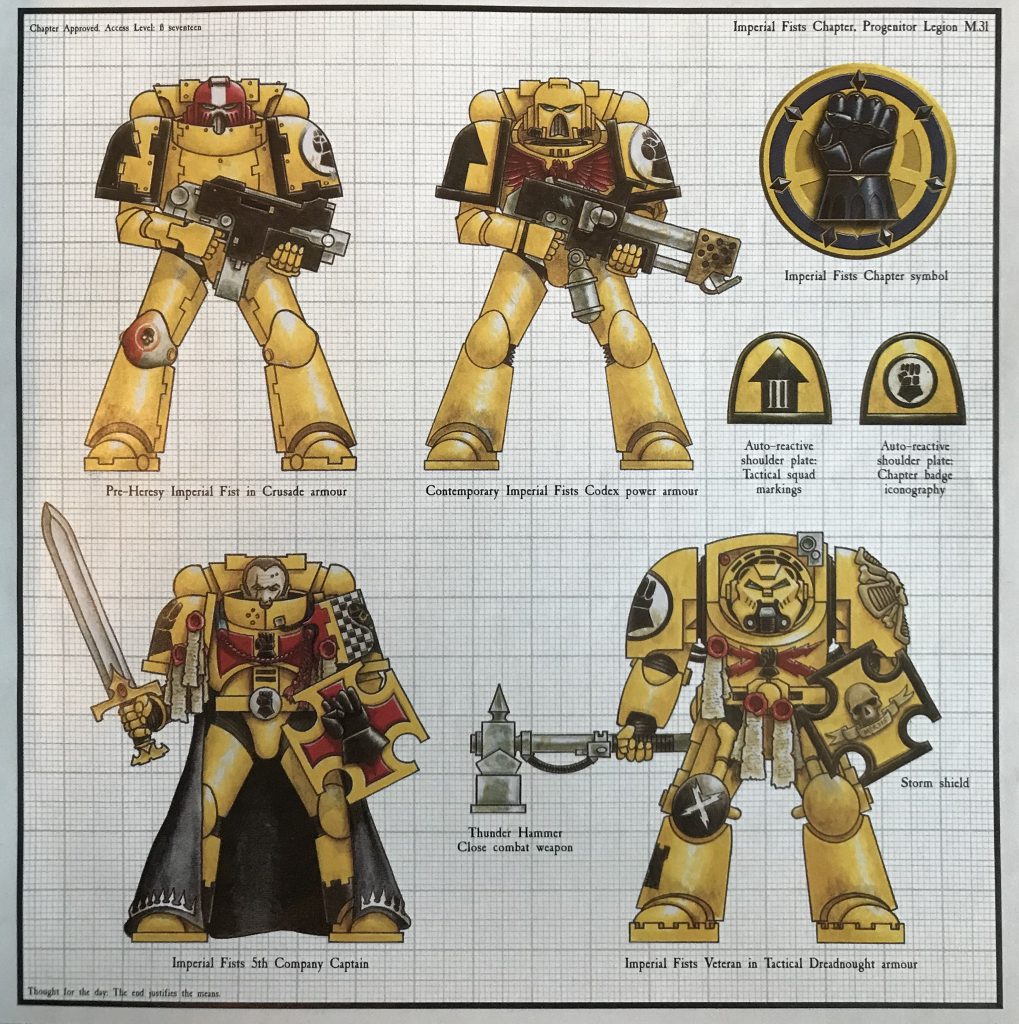
The Index Astartes series made White Dwarf required reading for the better part of three years, and not just for the rules – we were legitimately getting exciting new lore and backstory for a number of legions. To this day the series remains in my mind the pinnacle of what White Dwarf content can be.
Questions, comments, suggestions? Favourite articles, memories, battle reports to share? Leave a comment below or get in touch via contact@goonhammer.com
